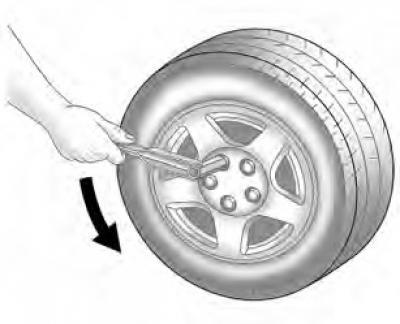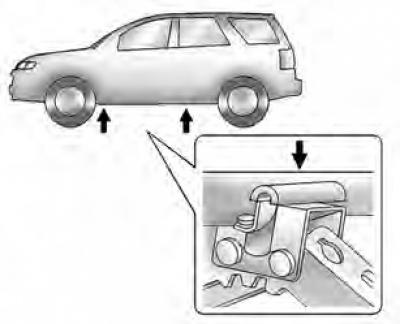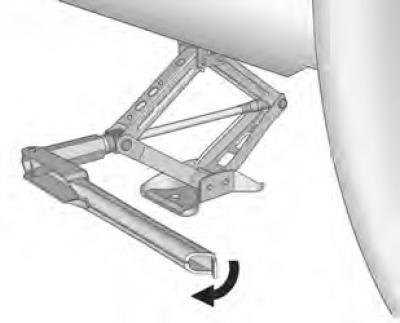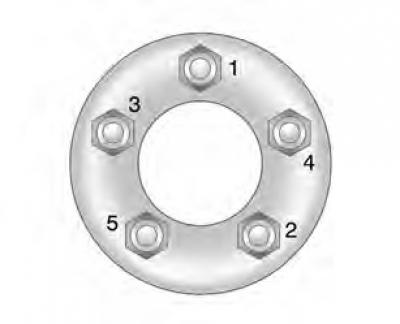When using tires of different sizes, brands or types (radial and radial-diagonal) possible violation of vehicle control, which can lead to an accident. Using tires of different sizes, brands or types can also cause damage to the vehicle. Use only tires of the correct size, brand and type on all wheels.
For some vehicles, a tire repair kit is supplied instead of a spare wheel.
See Tire repair kit.
Carry out the following preparatory work and observe the following instructions:
- Park your car at a sufficient distance from the main traffic.
- Park the vehicle on a level, firm and non-slip surface. The front wheels should point straight ahead.
- Apply the parking brake. For a manual transmission, select first or reverse gear. For automatic transmission, set the switch to position P.
- Turn off the engine and remove the ignition key.
- Turn on the hazard warning lights.
- Place wedges, blocks or stones at the front and rear of the wheel that is diagonal to the wheel being changed.
- Get all passengers out of the vehicle.
- Remove the spare wheel.
- It is strictly forbidden to change several wheels at the same time.
- The use of a jack is only allowed for changing a punctured tire and is not allowed for seasonal tire changes.
- If the ground on which the vehicle is parked is soft, place a firm pad under the jack (maximum 1 cm thick).
- There must be no people or animals in the posted car.
- Do not climb under a vehicle that has been jacked up.
- Do not turn on the engine with the vehicle raised.
- Clean the wheel nuts and threads before installing the wheel.
Warning: This jack has been designed specifically for this vehicle model.
It is not recommended to use it for other car models.
When working with a jack, it must not be allowed to exceed its maximum allowable load.
Use of this jack on other vehicles may damage the jack, damage the vehicle, or cause personal injury.
Replacing a damaged wheel
1. Remove the jack, wheel wrench or jack handle and spare wheel from the storage compartment in the luggage compartment and under the rear bumper.
2. Use a wheelbrace to loosen each wheel nut one turn.
Caution: Do not remove the nuts before lifting the wheel.

3. Insert the jack handle and wheel wrench into the jack.
4. To raise the wheel, turn the jack handle clockwise.
5. Install the jack as shown in the illustration below. There is a slot under the doors at the front and rear of the car.

6. Place a jack vertically under a reinforced area on the right or left side of the wheel to be replaced.
Caution: Do not attempt to raise the vehicle until the jack is installed and securely locked in the correct position.

7. Turn the wheelbrace or jack handle clockwise and carefully raise the vehicle until the jack is securely in place on the body and the wheel is 2.5 cm off the ground.
Attention: When lifting the car, make sure that the jack is securely positioned, otherwise it may slip out from under the car.
Note: The vehicle must be raised as high as necessary to change a wheel, but no higher.
Warning: Do not stand under a jacked up vehicle and do not start the engine.
The jack may slip out, resulting in serious injury or death.
8. Remove all nuts from the wheel by turning them counterclockwise.
9. Remove the tire along with the wheel.
10. Install the spare wheel on the hub.
Caution: Never lubricate wheel nuts with oil or grease.
Always use stock wheel nuts.
Have the nuts tightened to specification as soon as possible.
If the nuts are not tightened correctly, they can loosen over time.
11. Replace wheel nuts. Tighten each nut by hand to secure the wheel to the hub.
12. To put the vehicle on the ground, turn the wheelbrace or jack handle counterclockwise.
13. Tighten the wheel nuts crosswise to 125 N. 1→2→3→4→5 (see fig. below).

14. Hook the spare tire cable onto the support rod and, to tighten it, insert the bolt into the hole above the rear bumper and tighten it to 6 Nm.
15. Fasten the cable and install the plug in place.
Warning: Use only nuts and bolts of the correct size. Tighten threaded connections strictly to the recommended torque. Incorrect bolts and nuts or loose bolts and nuts can cause the wheel to loosen or even lose while running. This may lead to an accident.
16. Securely fix the jack and tool in their original position, and place the damaged wheel in the luggage compartment.
Caution: Do not store a damaged wheel under the rear bumper where the spare wheel was. A damaged wheel may move.
Warning: Do not leave the jack or tools inside the vehicle. Tools that are not properly secured can be dangerous to passengers in the event of an emergency braking of the vehicle or an accident.
Note: Temporary spare tire (dokatka) intended for short-term use only.
As soon as possible, contact a car service to replace the temporary spare wheel with a regular one.
Caution: When the vehicle is jacked up, it becomes unstable, which could cause damage to the vehicle and cause personal injury.
- Only use the supplied jack in the correct position.
- The jack must be set perpendicular to the ground.
- Do not stand under the jacked up vehicle.
- It is impossible to start the engine of the car standing on a jack.
- Before jacking up the car, all passengers must leave the car and move to a safe distance (including from other transport).
- The jack should only be used to change wheels.
- Do not jack up the vehicle on sloping or slippery surfaces.
- The jack should be installed directly next to the wheel to be replaced.
- It is necessary to block the wheel located diagonally with respect to the wheel to be replaced.
- Before jacking up the vehicle, make sure the parking brake is on and the shift lever is in 1st or reverse gear (for manual transmission), or in position "P" (for automatic transmission).
- Do not change a wheel near moving vehicles.
Attention: If there are no conditions for changing the wheel or confidence in your own abilities, contact a car workshop.
